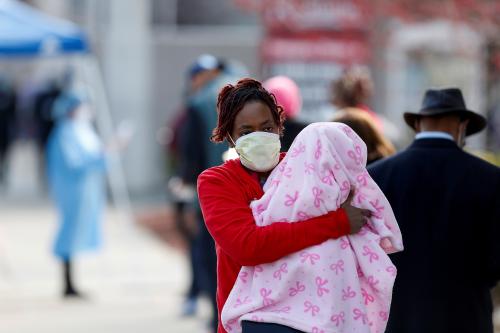The COVID-19 pandemic is forcing some major adjustments to many aspects of our daily lives that will likely remain long after the crisis recedes: virtual learning, telework, and fewer hugs and handshakes, just to name a few. But in addition, let’s hope the crisis also drives a permanent overhaul of the nation’s woefully inadequate worker safety net system.
In many hard-hit states, the pandemic-induced recession has shredded programs for workers’ economic security and career advancement. These have been long overdue for a modernization, having failed to provide security even before the pandemic, in an economy defined by technological disruptions, fast-evolving skill demands, and changing work regimens.
In Michigan, the social lockdown has already deeply affected workers living paycheck to paycheck, relatively few of whom had a durable salary or could work from home—resulting in the greatest number of unemployment insurance applicants in the nation. To put money in the pockets of laid-off workers, the federal CARES Act threw out the rule book for unemployment insurance (UI), which was originally designed in 1935 to provide temporary income support to full-time workers in highly cyclical manufacturing industries. The result is havoc in these state-run systems, which are crashing under the weight of a surge in applicants, a large number of whom work in the new normal of permanent “part-time” status or as independent contractors (so-called “gig” workers), who in normal times would not be eligible to apply for UI. States have struggled to quickly implement CARES Act changes into their systems due to historically low staffing levels and data systems from the 1980s.
As the pandemic exposes the shortcomings of our workers’ safety net, we must use the crisis to accelerate necessary changes to federal and state workforce policies. As argued in our recent Chicago Council on Global Affairs report, our country’s economic security and career advancement programs must be refashioned to adapt to occupational changes and new workplace realities.
The safety net we’ve been living with for decades was never designed to support today’s workplace and employment patterns and needs, such as the gig economy and contract work. And by tying workers to their current employer and occupation, it does the opposite of what today’s workers need most: help navigating changes in a labor market defined by constantly shifting skill demands, increasing AI and automation, and the disappearance of whole occupations in a flash, while others emerge just as quickly.
The nation’s antiquated safety net model was built out following the Depression and World War II, during a relatively brief period of American economic dominance. In 1975, as many as 55% of American men had employer-sponsored pensions, and by the mid-1960s, 80% had employer-sponsored health care. Unemployment insurance (first introduced in Wisconsin in 1932, then copied by other states as part of the 1935 Social Security Act) worked well for a while, particularly in the Midwest, where workers often cycled in and out of work in mills, factories, and machine shops.
This system began to unravel in the 1970s and 1980s as foreign competition and dramatic restructuring stressed these industries in the Midwest. Under the Reagan administration, federal policymakers started to intentionally dismantle worker safety net programs and decentralize their administration to the state and local levels.
From 2000 to 2010, economic dislocation spiked, with employment in manufacturing dropping 35% across six Midwestern states, eliminating 1.6 million jobs. This shift devastated employer-provided benefits and shredded the safety net for workers and their families. Most replacement jobs were in the service sector, which typically offered lower pay, fewer hours, and little or no benefits.
Today, pension plans provided through private companies have all but disappeared. The number of Fortune 500 firms offering pension plans dropped from nearly 60% in 1998 to 16% in 2015. In many cases, pensions were replaced by 401(k) retirement plans that place the onus for saving on the worker, not the company. Exacerbating the problem, it became harder to qualify for unemployment insurance; by 2016, only 27% of all unemployed workers qualified and received benefits, the lowest in 40 years.
Further compounding the need for change is the reality that the long-term economic impacts of COVID-19 will hit some regions harder than others, especially the “old economy,” or manufacturing-intensive states such as Wisconsin, Michigan, and Pennsylvania. These regional recessions mean our Midwest workers will, in the long run, be less likely to find work as automation accelerates, and laid-off workers’ skills atrophy. This will make it even more important to provide robust retraining and pathways for displaced adults for learning and work experience, all while providing some basics of income security, health care, and retirement benefits.
Granted, our freewheeling labor market has contributed much to the country’s economic dynamism and entrepreneurial capacity. Freed from sometimes-ossifying requirements around time-off guarantees and hourly restrictions seen in other countries, the U.S. labor market is characterized by fast churn and a relatively rapid ability to change.
We don’t want to lose the benefits of that labor market dynamism, which is why we must rethink how we provide basic health and income/retirement security, as well as how we reconnect people to work and opportunities for career advancement. A system geared to these new realities would include these key elements:
- Health care and pension benefits that are portable, universal, tied to individual employees, and delinked from full-time work and single employers, as well as benefits that are pro-rated for part-time employees based on hours worked. State governments have been experimenting with this over recent years in Washington, California, New York, and New Jersey.
- A simple, easy-to-access financial guarantee like the Tennessee Reconnect program for workers dislocated by trade or automation to afford upskilling or a postsecondary credential/degree. Brookings’s Annelies Goger recommends such training programs be accompanied by one-on-one career navigation assistance and multiple pathways to a quality job.
- Unemployment insurance reform, with more flexible eligibility requirements (currently waived by the CARES Act) so that intermittent workers (those with low and variable wages, part-time workers, and entrepreneurs starting their own small businesses) can access support. All state UI systems should incorporate and encourage employers to use innovations like work sharing, which allow more workers to stay employed while still getting some financial relief. (Work sharing has been adopted in over 20 states but not promoted or used—it is finally getting some recognition during this crisis.)
If we end up making these long-overdue changes to our economic security and career advancement programs, our economy will be more stable and our workforce more agile and secure—and we will have succeeded in turning a crisis into an opportunity.







Commentary
American workers’ safety net is broken. The COVID-19 crisis is a chance to fix it.
April 30, 2020